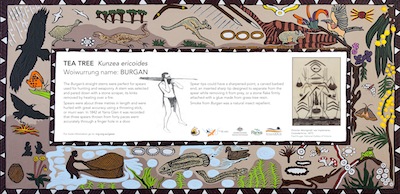.jpg)
TEXTS OF THE NEW GAWA TRAIL MARKERS


You can see large images of the new Gawa plaques here.
Plaque #1
TEA TREE Kunzea ericoides
Woiwurrung name: BURGAN
The Burgan’s straight stems were perfect for spears used for hunting and weaponry. A stem was selected and pared down with a stone scraper, its kinks removed by heating over a fire.
Spears were about three metres in length and were hurled with great accuracy using a throwing stick, or murri wan. In 1842 at Yarra Glen it was recorded that three spears thrown from forty paces went accurately through a finger hole in a door.
Spear tips could have a sharpened point, a carved barbed end, an inserted sharp tip designed to separate from the spear while removing it from prey, or a stone flake firmly attached with a glue made from grass-tree resin.
Smoke from Burgan was a natural insect repellent.
****************
Additional information
Distribution: A very hardy type of tea tree is still widely known by its Wurundjeri name Burgan. Prolific in coastal areas it will colonize land recovering from fire. It burns at a very high heat.
Uses:
1. Insect repellant. The leaves of the Burgan were burnt to give off an aromatic smoke which was useful for repelling insects.
2. Spears. The Wurundjeri used Burgan especially for making spears. A suitable straight stem, not too thin or thick ,would be selected and then pared down with a stone scraper. It was made perfectly straight by heating over a fire. Wurundjeri spears were about 3m long and could be hurled with great accuracy using a throwing stick or Garrick. It was recorded in 1842 that in Yarra Glen a demonstration of spear throwing was witnessed by William Thomas who recorded in his diary that “The spear was thrown from 40 paces away and went accurately through prepared latch holes”.
Because of the strength in this wood, Burgan spears were used to hunt large animals and for wars.
Spear tips were added in a variety of ways: with a carved barbed end; with an inserted sharp tip set in resin/gum designed to separate from the body of the spear when removing it from the speared animal; with a quartz flake firmly bound on with Kangaroo sinew.
Other spears were made from lighter wood. The abundant acacia provided spears for the hunting of smaller animals. A pronged spear was made out of native reeds for the spearing of fish.
3. Other tools. Tools such the Aboriginal woman’s digging sticks and clubs were also made from the hardy Burgan.
|
